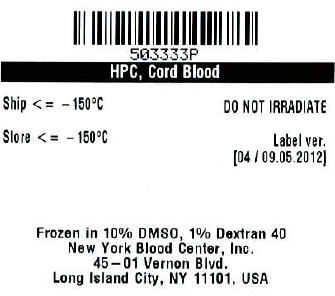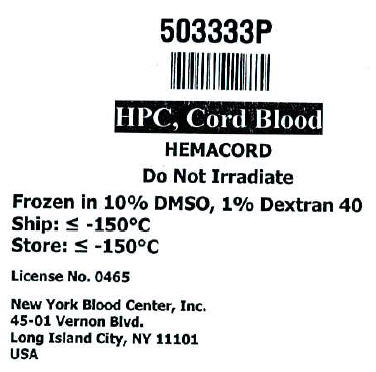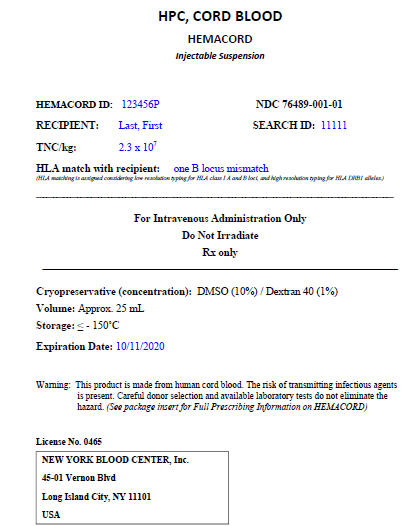Label: HEMACORD- human cord blood hematopoietic progenitor cell injection
- NDC Code(s): 76489-001-01, 76489-001-02
- Packager: New York Blood Center
- Category: CELLULAR THERAPY
- DEA Schedule: None
- Marketing Status: Biologic Licensing Application
Drug Label Information
Updated October 19, 2022
If you are a consumer or patient please visit this version.
- Download DRUG LABEL INFO: PDF XML
- Official Label (Printer Friendly)
-
HIGHLIGHTS OF PRESCRIBING INFORMATION
These highlights do not include all the information needed to use HEMACORD safely and effectively. See full prescribing information for HEMACORD.
HEMACORD (HPC, Cord Blood)
Injectable Suspension for Intravenous Use
Initial U.S. Approval: 2011WARNING: FATAL INFUSION REACTIONS, GRAFT VERSUS
HOST DISEASE, ENGRAFTMENT SYNDROME, AND GRAFT
FAILURE
See full prescribing information for complete boxed warning.- Fatal infusion reactions: Monitor patients during infusion and discontinue for severe reactions. ( 5.1, 5.2)
- Graft-vs-host disease (GVHD): GVHD may be fatal. Administration of immunosuppressive therapy may decrease the risk of GVHD ( 5.3)
- Engraftment syndrome: Engraftment syndrome may be fatal. Treat engraftment syndrome promptly with corticosteroids ( 5.4)
- Graft failure: Graft failure may be fatal. Monitor patients for laboratory evidence of hematopoietic recovery ( 5.5)
RECENT MAJOR CHANGES
Boxed Warning 5/2015
Contraindications ( 4.0) 5/2015
INDICATIONS AND USAGE
HEMACORD HPC, Cord Blood, is an allogeneic cord blood hematopoietic progenitor cell therapy indicated for use in unrelated donor hematopoietic progenitor cell transplantation procedures in conjunction with an appropriate preparative regimen for hematopoietic and immunologic reconstitution in patients with disorders affecting the hematopoietic system that are inherited, acquired, or result from myeloablative treatment ( 1)
The risk benefit assessment for an individual patient depends on the patient characteristics, including disease, stage, risk factors, and specific manifestations of the disease, on characteristics of the graft, and on other available treatments or types of hematopoietic progenitor cells ( 1)DOSAGE AND ADMINISTRATION
- For intravenous use only
- Do not irradiate
- Unit selection and administration of HEMACORD should be done under the direction of a physician experienced in hematopoietic progenitor cell transplantation ( 2)
- The recommended minimum dose is 2.5 X 10 7 nucleated cells/kg at cryopreservation ( 2.1)
- Do not administer HEMACORD through the same tubing with other products except for normal saline ( 2.3)
DOSAGE FORMS AND STRENGTHS
Each unit contains a minimum of 5 x 10 8 total nucleated cells with at least 1.25 x 10 6 viable CD34+ cells at the time of cryopreservation. The exact pre-cryopreservation nucleated cell content of each unit is provided on the container label and accompanying records (3)
CONTRAINDICATIONS
None (4)
WARNINGS AND PRECAUTIONS
ADVERSE REACTIONS
Mortality, from all causes, at 100 days post-transplant was 25% ( 5, 6.1)
The most common infusion-related adverse reactions (≥5%) are hypertension, vomiting, nausea, bradycardia, and fever ( 6.1)
To report SUSPECTED ADVERSE REACTIONS, contact the New York Blood Center at 1-866-767-NCBP (1-866-767-6227) and FDA at 1-800-FDA-1088 or www.fda.gov/medwatch
USE IN SPECIFIC POPULATIONS
Pregnancy: No animal or human data. Use only if clearly needed ( 8.1)
See 17 for PATIENT COUNSELING INFORMATION.
Revised: 5/2015
-
Table of Contents
FULL PRESCRIBING INFORMATION: CONTENTS*
WARNING: FATAL INFUSION REACTIONS, GRAFT VERSUS HOST DISEASE,
ENGRAFTMENT SYNDROME AND GRAFT FAILURE1 INDICATIONS AND USAGE
2 DOSAGE AND ADMINISTRATION
2.1 Dosing
2.2 Preparation for Infusion
2.3 Administration
3 DOSAGE FORMS AND STRENGTHS
4 CONTRAINDICATIONS
5 WARNINGS AND PRECAUTIONS
5.1 Hypersensitivity Reactions
5.2 Infusion Reactions
5.3 Graft-versus-Host Disease
5.4 Engraftment Syndrome
5.5 Graft Failure
5.6 Malignancies of Donor Origin
5.7 Transmission of Serious Infections
5.8 Transmission of Rare Genetic Diseases
6 ADVERSE REACTIONS
6.1 Clinical Trials Experience
8 USE IN SPECIFIC POPULATIONS
8.1 Pregnancy
8.4 Pediatric Use
8.5 Geriatric Use
8.6 Renal Disease
10 OVERDOSAGE
10.1 Human Overdosage Experience
10.2 Management of Overdose
11 DESCRIPTION
12. CLINICAL PHARMACOLOGY
12.1 Mechanism of Action
14 CLINICAL STUDIES
16 HOW SUPPLIED/STORAGE AND HANDLING
17 PATIENT COUNSELING INFORMATION
- *
- Sections or subsections omitted from the full prescribing information are not listed.
-
BOXED WARNING
(What is this?)
WARNING: FATAL INFUSION REACTIONS, GRAFT VERSUS HOST DISEASE,
ENGRAFTMENT SYNDROME AND GRAFT FAILUREFatal infusion reactions: HEMACORD administration can result in serious, including fatal, infusion reactions. Monitor patients and discontinue HEMACORD infusion for severe reactions. [See Warnings and Precautions ( 5.1, 5.2)]
Graft-vs-host disease (GVHD): GVHD is expected after administration of HEMACORD, and may be fatal. Administration of immunosuppressive therapy may decrease the risk of GVHD. [See Warnings and Precautions ( 5.3)]
Engraftment syndrome: Engraftment syndrome may progress to multiorgan failure and death. Treat engraftment syndrome promptly with corticosteroids. [See Warnings and Precautions ( 5.4)]
Graft failure: Graft failure may be fatal. Monitor patients for laboratory evidence of hematopoietic recovery. Prior to choosing a specific unit of HEMACORD, consider testing for HLA antibodies to identify patients who are alloimmunized. [See Warnings and Precautions ( 5.5)] -
1 INDICATIONS AND USAGE
HEMACORD, HPC (Hematopoietic Progenitor Cell), Cord Blood, is an allogeneic cord blood hematopoietic progenitor cell therapy indicated for use in unrelated donor hematopoietic progenitor stem cell transplantation procedures in conjunction with an appropriate preparative regimen for hematopoietic and immunologic reconstitution in patients with disorders affecting the hematopoietic system that are inherited, acquired, or result from myeloablative treatment.
The risk benefit assessment for an individual patient depends on the patient characteristics, including disease, stage, risk factors, and specific manifestations of the disease, on characteristics of the graft, and on other available treatments or types of hematopoietic progenitor cells.
-
2 DOSAGE AND ADMINISTRATION
- For intravenous use only.
- Do not irradiate.
Unit selection and administration of HEMACORD should be done under the direction of a physician experienced in hematopoietic progenitor cell transplantation.
2.1 Dosing
The recommended minimum dose is 2.5 x 10 7 nucleated cells/kg at cryopreservation. Multiple units may be required in order to achieve the appropriate dose.
Matching for at least 4 of 6 HLA-A antigens, HLA-B antigens, and HLA-DRB1 alleles is recommended. The HLA typing and nucleated cell content for each individual unit of HEMACORD are documented on the container label and/or in accompanying records.
2.2 Preparation for Infusion
HEMACORD should be prepared by a trained healthcare professional.
- Do not irradiate HEMACORD.
- See the appended detailed instructions for preparation of HEMACORD for infusion.
- Once prepared for infusion, HEMACORD may be stored at 4 to 25°C for up to 4 hours if DMSO is not removed, and at 4°C for up to 24 hours if DMSO is removed in a washing procedure [see Instructions for Preparation for Infusion] .
- The recommended limit on DMSO administration is 1 gram per kg body weight per day [see Warnings and Precautions ( 5.2) and Overdosage ( 10)].
2.3 Administration
HEMACORD should be administered under the supervision of a qualified healthcare professional experienced in hematopoietic progenitor cell transplantation.
- Confirm the identity of the patient for the specified unit of HEMACORD prior to administration.
- Confirm that emergency medications are available for use in the immediate area.
- Ensure the patient is hydrated adequately.
- Premedicate the patient 30 to 60 minutes before the administration of HEMACORD. Premedication can include any or all of the following: antipyretics, histamine antagonists, and corticosteroids.
- Inspect the product for any abnormalities such as unusual particulates and for breaches of container integrity prior to administration. Prior to infusion, discuss all such product irregularities with the laboratory issuing the product for infusion.
- Administer HEMACORD by intravenous infusion. Do not administer in the same tubing concurrently with products other than 0.9% Sodium Chloride, Injection (USP). HEMACORD may be filtered through a 170 to 260 micron filter designed to remove clots. Do NOT use a filter designed to remove leukocytes.
- For adults, begin infusion of HEMACORD at 100 milliliters per hour and increase the rate as tolerated. For children, begin infusion of HEMACORD at 1 milliliter per kg per hour and increase as tolerated. The infusion rate should be reduced if the fluid load is not tolerated. The infusion should be discontinued in the event of an allergic reaction or if the patient develops a moderate to severe infusion reaction. [See Warnings and Precautions ( 5.2) and Adverse Reactions ( 6).]
- Monitor the patient for adverse reactions during, and for at least six hours after, administration. Because HEMACORD contains lysed red cells that may cause renal failure, careful monitoring of urine output is also recommended.
-
3 DOSAGE FORMS AND STRENGTHS
Each unit of HEMACORD contains a minimum of 5.0 x 10 8 total nucleated cells with a minimum of 1.25 x 10 6 viable CD34+ cells, suspended in 10% dimethyl sulfoxide (DMSO) and 1% Dextran 40, at the time of cryopreservation.
The exact pre-cryopreservation nucleated cell content is provided on the container label and in accompanying records.
- 4 CONTRAINDICATIONS
-
5 WARNINGS AND PRECAUTIONS
5.1 Hypersensitivity Reactions
Allergic reactions may occur with infusion of HPC, Cord Blood, including HEMACORD. Reactions include bronchospasm, wheezing, angioedema, pruritus and hives [see Adverse Reactions ( 6)] . Serious hypersensitivity reactions, including anaphylaxis, also have been reported. These reactions may be due to dimethyl sulfoxide (DMSO), Dextran 40, or a plasma component of HEMACORD.
HEMACORD may contain residual antibiotics if the cord blood donor was exposed to antibiotics in utero. Patients with a history of allergic reactions to antibiotics should be monitored for allergic reactions following HEMACORD administration.
5.2 Infusion Reactions
Infusion reactions are expected to occur and include nausea, vomiting, fever, rigors or chills, flushing, dyspnea, hypoxemia, chest tightness, hypertension, tachycardia, bradycardia, dysgeusia, hematuria, and mild headache. Premedication with antipyretics, histamine antagonists, and corticosteroids may reduce the incidence and intensity of infusion reactions.
Severe reactions, including respiratory distress, severe bronchospasm, severe bradycardia with heart block or other arrhythmias, cardiac arrest, hypotension, hemolysis, elevated liver enzymes, renal compromise, encephalopathy, loss of consciousness, and seizure also may occur. Many of these reactions are related to the amount of DMSO administered. Minimizing the amount of DMSO administered may reduce the risk of such reactions, although idiosyncratic responses may occur even at DMSO doses thought to be tolerated. The actual amount of DMSO depends on the method of preparation of the product for infusion. Limiting the amount of DMSO infused to no more than 1 gram per kilogram per day is recommended [see Overdosage ( 10)].
If infusing more than one unit of HPC, Cord Blood, on the same day, do not administer subsequent units until all signs and symptoms of infusion reactions from the prior unit have resolved.
Infusion reactions may begin within minutes of the start of infusion of HEMACORD, although symptoms may continue to intensify and not peak for several hours after completion of the infusion. Monitor the patient closely during this period. When a reaction occurs, discontinue the infusion and institute supportive care as needed.
5.3 Graft-versus-Host Disease
Acute and chronic graft-versus-host disease (GVHD) may occur in patients who have received HEMACORD. Classic acute GVHD is manifested as fever, rash, elevated bilirubin and liver enzymes, and diarrhea. Patients transplanted with HEMACORD also should receive immunosuppressive drugs to decrease the risk of GVHD. [See Adverse Reactions ( 6.1).]
5.4 Engraftment Syndrome
Engraftment syndrome is manifested as unexplained fever and rash in the peri-engraftment period. Patients with engraftment syndrome also may have unexplained weight gain, hypoxemia, and pulmonary infiltrates in the absence of fluid overload or cardiac disease. If untreated, engraftment syndrome may progress to multiorgan failure and death. Begin treatment with corticosteroids once engraftment syndrome is recognized in order to ameliorate the symptoms. [See Adverse Reactions ( 6.1).]
5.5 Graft Failure
Primary graft failure, which may be fatal, is defined as failure to achieve an absolute neutrophil count greater than 500 per microliter blood by Day 42 after transplantation. Immunologic rejection is the primary cause of graft failure. Patients should be monitored for laboratory evidence of hematopoietic recovery. Consider testing for HLA antibodies in order to identify patients who are alloimmunized prior to transplantation and to assist with choosing a unit with a suitable HLA type for the individual patient. [See Adverse Reactions ( 6.1).]
5.6 Malignancies of Donor Origin
Patients who have undergone HPC, Cord Blood, transplantation may develop post-transplant lymphoproliferative disorder (PTLD), manifested as a lymphoma-like disease favoring non-nodal sites. PTLD is usually fatal if not treated.
The incidence of PTLD appears to be higher in patients who have received antithymocyte globulin. The etiology is thought to be donor lymphoid cells transformed by Epstein-Barr virus (EBV). Serial monitoring of blood for EBV DNA may be warranted in high-risk groups.
Leukemia of donor origin also has been reported in HPC, Cord Blood, recipients. The natural history is presumed to be the same as that for de novo leukemia.
5.7 Transmission of Serious Infections
Transmission of infectious disease may occur because HEMACORD is derived from human blood. Disease may be caused by known or unknown infectious agents. Donors are screened for increased risk of infection with human immunodeficiency virus (HIV), human T-cell lymphotropic virus (HTLV), hepatitis B virus (HBV), hepatitis C virus (HCV), T. pallidum, T. cruzi, West Nile Virus (WNV), transmissible spongiform encephalopathy (TSE) agents, and vaccinia. Donors are also screened for clinical evidence of sepsis, and communicable disease risks associated with xenotransplantation. Maternal blood samples are tested for HIV types 1 and 2, HTLV types I and II, HBV, HCV, T. pallidum, WNV, and T. cruzi. HEMACORD is tested for sterility. There may be an effect on the reliability of the sterility test results if the cord blood donor was exposed to antibiotics in utero. These measures do not totally eliminate the risk of transmitting these or other transmissible infectious diseases and disease agents. Report the occurrence of a transmitted infection to the New York Blood Center at 1-866-767-NCBP (1-866-767-6227).
Testing is also performed for evidence of donor infection due to cytomegalovirus (CMV). Test results may be found on the container label and/or in accompanying records.
5.8 Transmission of Rare Genetic Diseases
HEMACORD may transmit rare genetic diseases involving the hematopoietic system for which donor screening and/or testing has not been performed [see Adverse Reactions ( 6.1)] . Cord blood donors have been screened by family history to exclude inherited disorders of the blood and marrow. HEMACORD has been tested to exclude donors with sickle cell anemia, and anemias due to abnormalities in hemoglobins C, D, and E. Because of the age of the donor at the time HEMACORD collection takes place, the ability to exclude rare genetic diseases is severely limited.
-
6 ADVERSE REACTIONS
Day-100 mortality from all causes was 25%.
The most common infusion-related adverse reactions (≥ 5%) are hypertension, vomiting, nausea, bradycardia, and fever.
6.1 Clinical Trials Experience
Because clinical trials are conducted under widely varying conditions, adverse reaction rates observed in the clinical trials of a drug cannot be directly compared to rates in the clinical trials of another drug and may not reflect the rates observed in practice.
Infusion Reactions
The data described in Table 1 reflect exposure to 442 infusions of HPC, Cord Blood, (from multiple cord blood banks) in patients treated using a total nucleated cell dose ≥2.5 x 10 7/kg on a single-arm trial or expanded access use (The COBLT Study). The population was 60% male and the median age was 5 years (range 0.05-68 years), and included patients treated for hematologic malignancies, inherited metabolic disorders, primary immunodeficiencies, and bone marrow failure. Preparative regimens and graft-vs.-host disease prophylaxis were not standardized. The most common infusion reactions were hypertension, vomiting, nausea, and sinus bradycardia. Hypertension and any grades 3-4 infusion related reactions occurred more frequently in patients receiving HPC, Cord Blood, in volumes greater than 150 milliliters and in pediatric patients. The rate of serious adverse cardiopulmonary reactions was 0.8%.
Table 1: Incidence of Infusion-Related Adverse Reactions Occurring in ≥ 1% of Infusions (The COBLT Study) Any grade Grade 3-4 Any reaction 65.4% 27.6% Hypertension 48.0% 21.3% Vomiting 14.5% 0.2% Nausea 12.7% 5.7% Sinus bradycardia 10.4% 0 Fever 5.2% 0.2% Sinus tachycardia 4.5% 0.2% Allergy 3.4% 0.2% Hypotension 2.5% 0 Hemoglobinuria 2.1% 0 Hypoxia 2.0% 2.0% Information on infusion reactions was available from voluntary reports for 244 patients who received HEMACORD. The population included 56% males and 44% females with median age of 25 years (range 0.2-73 years). Preparative regimens and graft-vs.-host disease prophylaxis were not standardized. The reactions were not graded. An infusion reaction occurred in 18% of patients. The most common infusion reactions, occurring in ≥ 1% of patients, were hypertension (14%), nausea (5%), vomiting (4%), hypoxemia (3%), dyspnea (1%), tachycardia (1%), and cough (1%). The rate of serious adverse cardiopulmonary reactions was 0.1%.
Other Adverse Reactions
For other adverse reactions, the raw clinical data from the docket were pooled for 1299 (120 adult and 1179 pediatric) patients transplanted with HPC, Cord Blood, (from multiple cord blood banks) with total nucleated cell dose ≥ 2.5 x 10 7/kg. Of these, 66% (n=862) underwent transplantation as treatment for hematologic malignancy. The preparative regimens and graft-vs.-host disease prophylaxis varied. The median total nucleated cell dose was 6.4 x 10 7/kg (range, 2.5-73.8 x 10 7/kg). For these patients, Day-100 mortality from all causes was 25%. Primary graft failure occurred in 16%; 42% developed grades 2-4 acute graft-vs.-host disease; and 19% developed grades 3-4 acute graft-vs.-host disease.
Data from published literature and from observational registries, institutional databases, and cord blood bank reviews reported to the docket for HPC, Cord Blood, (from multiple cord blood banks) revealed nine cases of donor cell leukemia, one case of transmission of infection, and one report of transplantation from a donor with an inheritable genetic disorder. The data are not sufficient to support reliable estimates of the incidences of these events.
In a study of 364 patients, 15% of the patients developed engraftment syndrome.
-
8 USE IN SPECIFIC POPULATIONS
8.1 Pregnancy
Pregnancy Category C. Animal reproduction studies have not been conducted with HEMACORD. It is also not known whether HEMACORD can cause fetal harm when administered to a pregnant woman or can affect reproduction capacity. There are no adequate and well-controlled studies in pregnant women. HEMACORD should be used during pregnancy only if the potential benefit justifies the potential risk to the fetus.
8.4 Pediatric Use
HPC, Cord Blood, has been used in pediatric patients with disorders affecting the hematopoietic system that are inherited, acquired, or resulted from myeloablative treatment. [See Dosage and Administration ( 2), Adverse Reactions ( 6), and Clinical Studies ( 14).]
8.5 Geriatric Use
Clinical studies of HPC, Cord Blood, (from multiple cord blood banks) did not include sufficient numbers of subjects aged 65 years and over to determine whether they respond differently than younger subjects. In general, administration of HEMACORD to patients over age 65 years should be cautious, reflecting their greater frequency of decreased hepatic, renal, or cardiac function, and of concomitant disease or other drug therapy.
-
10 OVERDOSAGE
10.1 Human Overdosage Experience
There has been no experience with overdosage of HPC, Cord Blood, in human clinical trials. Single doses of HEMACORD up to 57.6 x 10 7 TNC/kg have been administered. HPC, Cord Blood, prepared for infusion may contain dimethyl sulfoxide (DMSO). The maximum tolerated dose of DMSO has not been established, but it is customary not to exceed a DMSO dose of 1 gm/kg/day when given intravenously. Several cases of altered mental status and coma have been reported with higher doses of DMSO.
-
11 DESCRIPTION
HEMACORD consists of hematopoietic progenitor cells, monocytes, lymphocytes, and granulocytes from human cord blood for intravenous infusion. Blood recovered from umbilical cord and placenta is volume reduced and partially depleted of red blood cells and plasma.
The active ingredient is hematopoietic progenitor cells which express the cell surface marker CD34. The potency of cord blood is determined by measuring the numbers of total nucleated cells (TNC) and CD34+ cells, and cell viability. Each unit of HEMACORD contains a minimum of 5 x 10 8 total nucleated cells with at least 1.25 x 10 6 viable CD34+ cells at the time of cryopreservation. The cellular composition of HEMACORD depends on the composition of cells in the blood recovered from the umbilical cord and placenta of the donor. The actual nucleated cell count, the CD34 + cell count, the ABO group, and the HLA typing are listed on the container label and/or accompanying records sent with each individual unit.
HEMACORD has the following inactive ingredients: dimethyl sulfoxide (DMSO), Dextran 40, and citrate phosphate dextrose adenine 1 (CPDA-1). When prepared for infusion according to instructions, the infusate contains the following inactive ingredients: Dextran 40, human serum albumin, and residual DMSO and citrate phosphate dextrose adenine 1 (CPDA-1).
-
12. CLINICAL PHARMACOLOGY
12.1 Mechanism of Action
Hematopoietic stem/progenitor cells from HPC, Cord Blood, migrate to the bone marrow where they divide and mature. The mature cells are released into the bloodstream, where some circulate and others migrate to tissue sites, partially or fully restoring blood counts and function, including immune function, of blood-borne cells of marrow origin. [See Clinical Studies ( 14).]
In patients with enzymatic abnormalities due to certain severe types of storage disorders, mature leukocytes resulting from HPC, Cord Blood, transplantation may synthesize enzymes that may be able to circulate and improve cellular functions of some native tissues. However, the precise mechanism of action is unknown.
-
14 CLINICAL STUDIES
The effectiveness of HPC, Cord Blood, as defined by hematopoietic reconstitution, was demonstrated in one single-arm prospective study, and in retrospective reviews of data from an observational database for HEMACORD and data in the dockets and public information. Of the 1299 patients in the docket and public data, 66% (n=862) underwent transplantation as treatment for hematologic malignancy. Results for patients who received a total nucleated cell dose ≥2.5 x 10 7/kg are shown in Table 2. Neutrophil recovery is defined as the time from transplantation to an absolute neutrophil count more than 500 per microliter. Platelet recovery is the time to a platelet count more than 20,000 per microliter. Erythrocyte recovery is the time to a reticulocyte count greater than 30,000 per microliter. The total nucleated cell dose and degree of HLA match were inversely associated with the time to neutrophil recovery in the docket data.
Table 2: Hematopoietic Recovery for Patients Transplanted with HPC, Cord Blood, Total Nucleated Cell (TNC) Dose ≥ 2.5 x 10 7/kg *HPC, Cord Blood (from multiple cord blood banks) Data Source The COBLT
Study*Docket* and
Public Data*HEMACORD Design Single-arm
prospectiveRetrospective Retrospective Number of patients 324 1299 155 Median age (years)
(range)4.6
(0.07 – 52.2)7.0
(<1 – 65.7)14.5
(0.2 – 72.6)Gender 59% male
41% female57% male
43% female54% male
46% femaleMedian TNC Dose (x 10 7/kg)
(range)6.7
(2.6 – 38.8)6.4
(2.5 – 73.8)4.9
(2.5 – 39.8)Neutrophil Recovery at Day 42
(95% CI)76%
(71% – 81%)77%
(75% – 79%)83%
(76% – 88%)Platelet Recovery at Day 100 of
20,000/microliter (95% CI)57%
(51% – 63%)- 77%
(69% – 84%)Platelet Recovery at Day 100 of
50,000/microliter (95% CI)46%
(39% – 51%)45%
(42% – 48%)- Erythrocyte Recovery at Day 100
(95% CI)65%
(58% – 71%)- - Median time to Neutrophil
Recovery27 days 25 days 20 days Median time to Platelet Recovery
of 20,000/microliter90 days - 45 days Median time to Platelet Recovery
of 50,000/microliter113 days 122 days - Median time to Erythrocyte
Recovery64 days - - -
16 HOW SUPPLIED/STORAGE AND HANDLING
HEMACORD is supplied as a cryopreserved cell suspension in a sealed bag containing a minimum of 5 x 10 8 total nucleated cells with a minimum of 1.25 x 10 6 viable CD34+ cells in a volume of 25 milliliters (NDC# 76489-001-01). The exact pre-cryopreservation nucleated cell content is provided on the container label and accompanying records.
Store HEMACORD at or below -150 °C until ready for thawing and preparation.
-
17 PATIENT COUNSELING INFORMATION
Discuss the following with patients receiving HEMACORD:
- Report immediately any signs and symptoms of acute infusion reactions, such as fever, chills, fatigue, breathing problems, dizziness, nausea, vomiting, headache, or muscle aches.
- Report immediately any signs or symptoms suggestive of graft-vs.-host disease, including rash, diarrhea, or yellowing of the eyes.
-
INSTRUCTIONS FOR PREPARATION FOR INFUSION
1 REQUIRED EQUIPMENT, REAGENTS, AND SUPPLIES
Equipment Biological Safety Cabinet (BSC)
Refrigerated blood bank centrifuge
Plasma extractor
Digital balance
Tube sealer compatible with PVC plastic
Automated cell counter
Microscope and chamber for determining cell count and viability (optional)
Water bath (4 liters or more)
Canister opening tool
Orbital Rotator
Reagents
5% Albumin (human), USP
10% Dextran 40, USP
Bacterial culture bottles (aerobic and anaerobic)
Supplies
Cell Wash/Infusion Bag Set (Transplant Set) (included with HEMACORD)
Sterile Disposable Syringes: 3 mL, 30 mL and 60 mL
Sterile tubing
18 gauge injection needles
Sterile gloves
Hemostats
Sterile small plastic zipper-lock bags
Alcohol prep pads
Iodine swab sticks
Sampling site couplers
Tubes for cell counts, progenitor assays (optional)
Protective cryogloves
Transfer pack containers 300 mL
Instructions for preparation for infusion
2 VERIFICATION OF PRODUCT IDENTITY
HEMACORD is shipped frozen in a steel canister that is contained in an insulating foam sleeve. HEMACORD must be kept at or below -150 °C, either inside the container used for shipping (Dry-Shipper) or in a Liquid Nitrogen (LN 2)-cooled storage device at the Transplant Center (recommended).
The bar-coded ID label of the product is affixed to the canister (Figure 1).
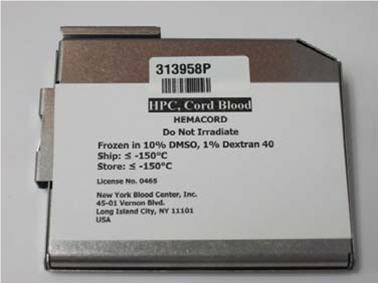
Figure 1
- Check the HEMACORD ID label to confirm its identity with the ID of the expected product as soon as it is received.
- Wearing protective cryogloves, transfer the HEMACORD from the Dry-Shipper to the vapor phase of a LN 2 storage tank.
- Use the canister opening tool to pry canister open at top and bottom, as shown below in Figures 2 and 3.
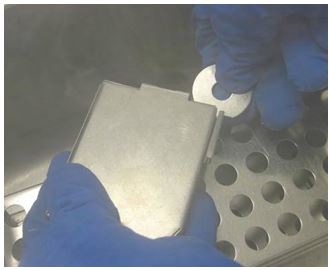
Figure 2.
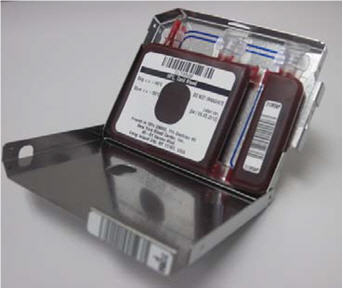
Figure 3.
- Work carefully to avoid damaging the frozen plastic product bag.
- Check the bar-coded label on the product against your records to verify that the bar-coded and visually-readable printed number absolutely conforms to the information previously provided and the documentation included with the HEMACORD product.
- Document this check on the “Unit Receipt Form” document received with the product.
NOTE:
If there is any error or ambiguity with regard to the product ID, close the
canister and keep the product at LN 2 temperature. Immediately advise the staff
of the New York Blood Center, Inc. (NYBC) and the transplant physician . Do
not proceed until the problem is resolved. If your LN 2 storage tanks have no
space to store the product in its canister and insulated sleeve, add LN 2 to the
NYBC dry-shipper to maintain the product frozen until a completely
satisfactory determination is made.3 METHOD
3.1 Preparation of Thawing Solutions
- Prepare the thawing solution (also called reconstitution solution) at room temperature, mixing equal volumes of 10% Dextran 40 and 5% human albumin, in a biological safety cabinet. The final concentration in the thawing solution is 5% Dextran 40 and 2.5% human albumin.
- Attach an 18 gauge needle to a 30 cc syringe. Draw approx. 12.5 mL of 10% Dextran 40 and approx. 12.5 mL of 5% human albumin into the syringe. The contents of this syringe are to be used for diluting the cell suspension after thawing.
- Fit 18 gauge needles to three 60 mL syringes. Draw 30 mL of 10% Dextran 40 and 30 mL of 5% human albumin into each syringe. Two of these 60 mL syringes will be used in steps “l” and “o” in section 3.4 of this procedure. The third syringe will be used in step “l” of section 3.5.
- Alternatively, prepare the thawing solution in a 300-mL transfer bag by adding, using syringes, 150 mL 10% Dextran 40 and 150 mL 5% albumin.
3.2 Thawing HEMACORD
Wearing protective cryogloves, remove the canister with HEMACORD from the LN 2 container. Keep the canister in the vapor phase, just above the surface of the LN 2 for 5-10 minutes before proceeding.
Note: If two different HEMACORD products are stored in the LN 2 container at the same time, open one canister at a time with the canister opening tool as described above. Carefully check the ID number on the labels attached to the canister and the product, respectively. Close the canister and leave it in the vapor phase for 5-10 min. before proceeding.
- Open canister with the canister opening tool as described above.
- Work carefully to avoid damaging the frozen plastic product bag. Remember that plastic at this temperature is very brittle and breaks easily.
- Examine the bag for breaks or cracks and document this inspection on the appropriate form.
- Remove the HEMACORD from the canister.
Caution! Do not handle the plastic bags at liquid nitrogen temperature with the tongs intended for metal canisters, as this may rip the bag. Do not allow the product or tubing to bend as it may crack. Do not press on, bend or stretch the frozen bridges of the bag or segment seal: they are brittle and might break. (Figures 4a. and 4b.)
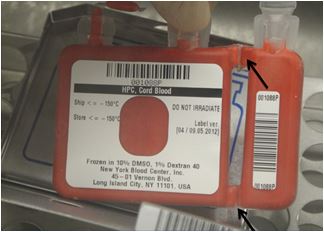
Figure 4a. HEMACORD in two-compartment freezing bag after removal from LN 2 storage and opening the canister (front view). Arrows point to sealed bridges disclosing folding of the bridges.

Figure 4b. Same bag as in Figure 4a. (back view).
- Put the HEMACORD inside a zipper-locked plastic bag, let the air out and close the bag. Place the bag with the HEMACORD in a warm water bath at approximately 38°C.
- To accelerate and homogenize thawing, carefully agitate the product bag in the water and gently knead its contents.
- Inspect and watch for leakage. If product leaks out into the zipper-locked bag, find the site of the leak in the freezing bag and position the bag so as to prevent further escape of product. While maintaining the bag in that position, finish thawing the product. (See Section 5 for emergency product recovery in the event of a container failure.)
- As soon as the bag’s contents become slushy, remove the bag from the water bath and place it inside a biological safety cabinet.
3.3 Connecting the Freezing Bag to the Transplant Set
The procedure to restore the osmolarity of the HEMACORD cell suspension, and either remove the supernatant with DMSO or simply dilute the thawed HEMACORD, is assisted by a sterile, empty, transplant bag set designed with two spike tubes to drain both compartments of the freezing bag (see Figure 5: “Cell Wash/Infusion Bag Set”). The Cell Wash/Infusion Bag Set is included with this shipment.
Note: The following procedure must be done in a biological safety cabinet.
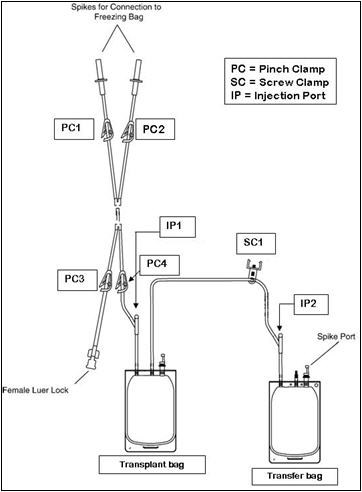
Figure 5. Cell Wash/Infusion Bag Set
- Close all clamps on the Cell Wash/Infusion Bag Set.
- Remove the HEMACORD freezing bag from the zipper-locked bag.
- Disinfect the covers of both ports of the freezing bag with iodine.
- Using a clean and disinfected scissors, cut off the hermetically sealed covers of the freezing bag’s spike ports (Figure 6).
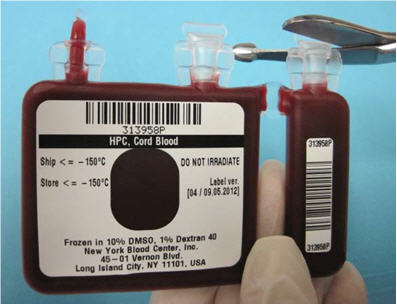
Figure 6.
- Disinfect the cut surfaces of the spike port area of the freezing bag using iodine swab sticks (Figure 7).

Figure 7.
- Insert the spikes of the Cell Wash/Infusion Bag Set into the ports of the freezing bag.
- Label the transplant bag (shown in Figure 5) with HEMACORD ID number and the name of the recipient (or label according to local standard operating procedure).
3.4 Reconstitute (dilute) the thawed HEMACORD
The amount of thawing solution used for HEMACORD is at least 5 times the volume of the frozen product including the cryoprotectant. For example, 25 mL products are diluted to 170 mL total, and thus, a volume of 145 mL of thawing solution is required to make the final volume of 170 mL in a transplant bag.
- Add first a volume of thawing solution equal to the volume of thawed HEMACORD (1:1 ratio).
- Attach the 30 cc syringe with the 25 mL thawing solution to the female luer lock of the Cell Wash/Infusion Bag Set.
- Open PC-1, PC-2 and PC-3 (see Figure 5 above) and slowly introduce half (~12.5 mL) of the thawing solution to the 25 mL product in the freezing bag while mixing the fluids in the bag using an orbital rotator.
- Rinse well to remove cells from the bag’s ports.
- Close PC-3. Open PC-4 and drain the contents from the freezing bag into the transplant bag.
- Close PC-1 and PC-2. Open PC-3.
- Slowly add the remaining thawing solution (~12.5 mL) to the transplant bag while mixing the fluids in the bag.
- Close PC-3.
- Allow approx. 5 minutes for equilibration.
- Open PC-1 and PC-2. Pass the diluted HEMACORD back and forth between the transplant bag and the freezing bag in order to more completely wash all cells out of the freezing bag and into the transplant bag.
- Close PC-1 and PC-2.
- Attach a syringe with 60 mL thawing solution to the luer lock.
- Open PC-3.
- Transfer the 60 mL solution to the diluted HEMACORD in the transplant bag while mixing the fluids in the bag.
- Repeat with a second 60 mL syringe. The final volume should be approx. 170 mL (50 mL diluted HEMACORD with 120 mL thawing solution).
- Close PC-3. Open PC-1 and PC-2.
- Pass the reconstituted HEMACORD back and forth between the transplant bag and the freezing bag in order to wash all cells completely out of the freezing bag and into the transplant bag.
- Close PC-4.
- Seal the Cell Wash/Infusion Bag Set tubing between PC-4 and IP-1.
- Cut through seal to separate the transplant bag from the freezing bag.
- Discard the freezing bag, the luer lock, and the connecting tubing.
- The reconstituted product can be used for infusion into a patient with or without the additional step of DMSO removal (Section 3.5 below).
- The recommended expiration time of the reconstituted unwashed HEMACORD is four hours either at room temperature or at 4 °C from the time of thaw.
- Remove a small volume from the reconstituted product for Complete Blood Counts (CBC), CFU, CD34+ counts, viability, and sterility samples (bacterial and fungal cultures) as per transplant center procedures.
NOTE: If more than four hours elapse between thawing and infusion, an aliquot of the product should be removed and tested immediately before administration to the patient to determine the cell viability of the infused product.
- Call the Transplant Unit to advise them that the product is ready for infusion if you do not intend to remove the cryoprotectant.
3.5 Removing the Cryoprotectant (Washing)
- Place the transplant bag and the transfer bag in a centrifuge cup.
- Fully support the transplant bag with inserts to prevent formation of creases during centrifugation (as shown in Figure 8 below).
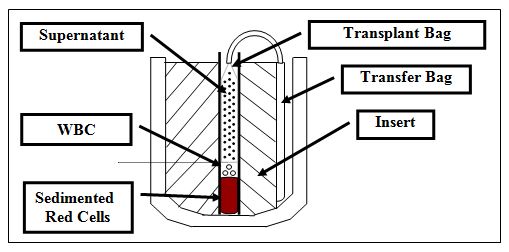
Figure 8.
- Close SC-1 securely.
- Centrifuge at 400 x G for 20 minutes at 10°C.
- After centrifugation, carefully remove the bags from the centrifuge bucket without disturbing the cellular pellet in the transplant bag.
- Place the transplant bag in the plasma extractor.
- Using SC-1 to adjust the flow, very slowly transfer approximately 2/3 of the supernatant (Supernatant-1) to the transfer bag avoiding the passage of cells.
- Leave approximately 1/3 of supernatant with the cells (white and sedimented red cells in the diagram above). If you detect passage of cells to the transfer bag, return the contents to the transplant bag, resuspend the cells, and repeat the centrifugation or centrifuge only the Supernatant-1 bag (as described below).
- Empty the tubing between the bags by pushing air from the transfer bag to the transplant bag.
- Close SC-1.
- Seal the tubing between the bags close to the transplant bag. Cut through the seal and disconnect the transfer bag with the Supernatant-1 from the transplant bag with the cellular pellet (product).
- Resuspend the cellular pellet by slowly adding (with a syringe) 25-50 mL of the thawing solution through the IP-1, with continuous mixing. The resuspended cells constitute the Sediment-1 (the graft).
- The weight of the empty transplant bag is 23.6 g if cut and sealed as shown below (Figure 9). Calculate the weight of the Sediment-1 by weighing the filled transplant bag and subtracting 23.6 g.
- Remove a small volume from the Sediment-1 for cell count, viability determination, and sterility (bacterial and fungal cultures).
- The recommended expiration time for HEMACORD after the removal of the cryoprotectant is 24 hours from the date and time of thaw. Store the product at 4 °C in a blood storage refrigerator until the product is used.
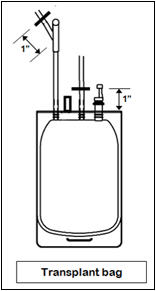
Figure 9.
- Inspect the supernatant for escaped cells, even if there is no appearance of escape.
- Express 10 mL from the Supernatant-1 bag into a conical centrifuge tube (accurate volume will help the accuracy of estimations).
- Centrifuge at 600 x G for 10 minutes.
- Carefully aspirate 9.5 mL of supernatant without disturbing the (possible) cell pellet in the tip of the tube.
- Resuspend the cell pellet thoroughly in the 0.5 mL of supernatant and load into a cell-counting chamber.
- Count the nucleated cells per microliter and calculate the total number of cells in the remaining volume of Supernatant-1.
- Determine the number of nucleated cells in Supernatant-1 per kg of patient’s weight. The transplant physician may decide whether to add these cells to Sediment-1 cells (the graft) in cases where the Sediment-1 cell dose is low or borderline.
- If collection of escaped cells from the bag containing Supernatant-1 is desired:
- Centrifuge the Supernatant-1 bag at 400 X G for 20 minutes at 10 °C to sediment the cells.
- In a laminar flow hood, connect a 300 mL transfer bag to the bag containing the centrifuged product.
- Position the bag in the plasma extractor and express the new supernatant (Supernatant-2) into the transfer bag, leaving the sedimented cells (Sediment-2) in the original bag.
- Seal the tubing between the bags, cut through the seal, and disconnect the transfer bag with the Supernatant-2 from the original bag with the Sediment-2.
- Resuspend the Sediment-2 in 10-15 mL thawing solution, using a syringe and mixing gently. The transplant physician may modify the volume for injection if preferred. If volume modification is desired, resuspend the cellular pellet to the final volume by injecting with thawing solution.
- Weigh the Supernatant-2 bag and the Sediment-2 bag, and calculate the volumes by subtracting the weight of the empty bags similarly sealed.
- Remove a small volume from the Sediment-2 for cell count, viability determination, and sterility testing.
- Bring the transplant bag (Sediment-1 bag) to the Transplant Unit, even if the second bag (Sediment-2 bag) is being prepared; the second bag can be infused separately afterwards.
4. ADMINISTRATIVE REQUIREMENTS
- Prepare a report on the procedure. Note the condition of the HEMACORD bag, including whether and at what stage leaks or cracks were detected. Record the following:
HEMACORD ID number
Date of receipt of the HEMACORD
Liquid Nitrogen Storage conditions in your facility
Date of thawing
Volume of the final product
Total nucleated cell (TNC) count, CD34+ content
Viability of the cells recovered (TNC or CD34+ cells) and the method used
Results of bacterial and fungal cultures - E-mail or fax a copy of the report to the New York Blood Center, Inc.
Email: ncbp@nybloodcenter.org
Fax: (718) 707-3747 - Keep a copy for your processing lab records.
- Return the dry shipper to the New York Blood Center, Inc. The return address is:
New York Blood Center, Inc.
National Cord Blood Program
45-01 Vernon Blvd.
Long Island City, NY 11101
Ph: (718) 706-5211
Fax: (718) 707-3741
5. EMERGENCY PRODUCT RECOVERY IN THE EVENT OF A CONTAINER FAILURE
- To prevent accidental fracture, handle the HEMACORD bags with extreme caution when removing them from the protective metal cassettes, during inspection, and during the thawing process.
- Perform the thawing process in a controlled laboratory environment that provides appropriate equipment and supplies for post-thaw sampling and/or bag rescue, as well as dedicated space and personnel for product preparation.
- To mitigate the extreme temperature change from storage at -196 °C (Liquid Nitrogen phase) to thawing at 38°C, and possible sudden vaporization of liquid nitrogen in recess of the bag or tubing, hold the HEMACORD bag in the vapor phase for a few minutes following removal from the liquid phase of nitrogen before removal for thawing.
- To prevent an accidental drop onto the floor, handle HEMACORD bags over a flat surface, such as a table.
- Place HEMACORD bags in individual sterile zipper-locked bags prior to thawing to facilitate salvage of the product and to reduce contamination in case of an unanticipated problem.
- If the HEMACORD bag is obviously fractured upon removal from cold storage, or if it fractures during the thawing process, please notify the Processing Laboratory of the National Cord Blood Program at the New York Blood Center [phone number: 718-706-5211 or 1-866-767-NCBP (1-866-767-6227)] as soon as possible. Notify the transplant physician and the laboratory director immediately.
- It is the transplant physician’s (or designee’s) responsibility to determine whether the HEMACORD product will be used or discarded and whether additional product(s) are to be requested for infusion.
- If the transplant physician (or designee) determines that the product in a ruptured bag should be used, the HEMACORD product may be recovered as follows:
- Place the ruptured bag into the sterile zipper-locked plastic bag to prevent further loss and/or contamination of the product during the thawing process.
- Thaw the product according to the Section 3 above. Small leaks or tears of the ruptured bag can be blocked off with hemostat clips.
- Withdraw the thawed product from the freezing bag and any product from the zipper-locked bag into one or more 60 mL syringe(s) with sterile tubing attached.
- Inside a biological safety cabinet, transfer the product into a new bag using a sterile syringe. (This new bag could be either the sterile transplant bag that is provided with the HEMACORD product or a bag of a stocked salvage kit that should be readily available in the thawing laboratory for use in these situations.)
- Save an aliquot of the product to send for gram stain and bacterial and fungal cultures.
- Dilute (reconstitute) the thawed HEMACORD and remove the cryoprotectant according to the procedure described above or administer the diluted product to the patient as per transplant physician’s instructions.
- It is the transplant physician’s (or designee’s) responsibility to determine whether to treat the patient with broad-spectrum antibiotic coverage and the necessity for an infectious disease consultation.
- If possible, place the ruptured bag (with or without the product) into a biohazard bag and save for reference when notifying the National Cord Blood Program at the New York Blood Center. This staff will notify the manufacturer and provide information for returning the bag to the manufacturer for evaluation.
- Notify the National Cord Blood Program at the New York Blood Center [phone number: 718-706-5211 or 1-866-767-NCBP (1-866-767-6227)].
Distributed by:
New York Blood Center, Inc.
45-01 Vernon Boulevard
Long Island City, NY 11101
License No. 0465
Issued: 02/2012 - PRINCIPAL DISPLAY PANEL
- PRINCIPAL DISPLAY PANEL
- PRINCIPAL DISPLAY PANEL
-
INGREDIENTS AND APPEARANCE
HEMACORD
human cord blood hematopoietic progenitor cell injectionProduct Information Product Type CELLULAR THERAPY Item Code (Source) NDC:76489-001 Route of Administration INTRAVENOUS Active Ingredient/Active Moiety Ingredient Name Basis of Strength Strength HUMAN CORD BLOOD HEMATOPOIETIC PROGENITOR CELL (UNII: XU53VK93MC) (HUMAN CORD BLOOD HEMATOPOIETIC PROGENITOR CELL - UNII:XU53VK93MC) HUMAN CORD BLOOD HEMATOPOIETIC PROGENITOR CELL 500000000 in 25 mL Inactive Ingredients Ingredient Name Strength DIMETHYL SULFOXIDE (UNII: YOW8V9698H) Packaging # Item Code Package Description Marketing Start Date Marketing End Date 1 NDC:76489-001-02 1 in 1 CANISTER 1 NDC:76489-001-01 25 mL in 1 BAG; Type 0: Not a Combination Product Marketing Information Marketing Category Application Number or Monograph Citation Marketing Start Date Marketing End Date BLA BLA125397 11/10/2011 Labeler - New York Blood Center (073271827) Establishment Name Address ID/FEI Business Operations New York Blood Center, Inc. 073271827 analysis(76489-001) , api manufacture(76489-001) , label(76489-001) , manufacture(76489-001) , pack(76489-001)




